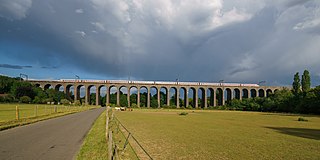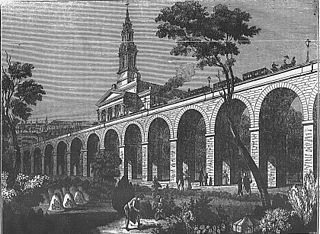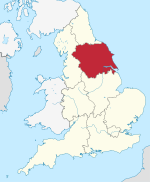
Skidby is a small village and civil parish in Yorkshire Wolds of the East Riding of Yorkshire, England. It is situated about 6 miles (10 km) north-west of Hull city centre, 2.2 miles (3.5 km) west of Cottingham and 5 miles (8 km) south of Beverley.
Monsal Dale is a valley in Derbyshire, England, in the White Peak limestone area of the Peak District National Park. It is a Site of Special Scientific Interest (SSSI), a Special Area of Conservation (SAC) (1) and part of a Europe-wide network called Natura 2000.

Whalley railway station serves the village of Whalley in Lancashire, England. The station lies on the Ribble Valley Line 7+1⁄4 miles (11.7 km) north of Blackburn. The station has two platforms, slightly offset from each other. It is unstaffed, with shelters on each platform. Immediately beyond its eastern end, the line crosses the River Calder on a 678-yard (620 m) long, brick viaduct of 48 arches.

The Cornwall Railway company constructed a railway line between Plymouth and Truro in the United Kingdom, opening in 1859, and extended it to Falmouth in 1863. The topography of Cornwall is such that the route, which is generally east–west, cuts across numerous deep river valleys that generally run north–south. At the time of construction of the line, money was in short supply due to the collapse in confidence following the railway mania, and the company sought ways of reducing expenditure.

The Digswell Viaduct, also called Welwyn Viaduct, is a railway viaduct that carries the East Coast Main Line over the River Mimram in the county of Hertfordshire in England. A prominent local landmark, it is located between Welwyn Garden City and Digswell. It is just to the south of Welwyn North railway station.

The Landore viaduct is a railway viaduct over the Swansea valley and the River Tawe at Landore in south Wales. It provides a link between Swansea city center and the West Wales Line to the South Wales Main Line. The valley crossing provides a panoramic view of Landore, Kilvey Hill, the Liberty Stadium and the Swansea Enterprise Park.

Oaks Viaduct spanned the Dearne Valley, in South Yorkshire, England. The viaduct was 1,087 feet (331 m) long and crossed Pontefract Road at Hoyle Mill, and spanned the Dearne Valley including the Dearne and Dove Canal and the Barnsley Coal Railway. It carried the Midland Railway's Cudworth-Barnsley branch. It opened to goods traffic in 1869 and to passenger traffic in 1870. On the Barnsley side the line gave access to Barnsley Main Colliery. The line also served Monk Bretton Colliery and a stub at the Cudworth end is still used to deliver sand to Refearn's Glass Works at Monk Bretton.

Elephant & Castle railway station is a National Rail station in Newington, south London. Along with the London Underground station of the same name, it is located in the London Borough of Southwark and is in both Travelcard Zone 1 and 2. The station is managed by Thameslink, with services operated by both Thameslink and Southeastern. There is out-of-station interchange with the nearby Elephant & Castle tube station.
Clifton Viaduct is a Grade II listed stone structure crossing the valley of the River Irwell in Clifton, Greater Manchester, and also the Manchester, Bolton and Bury Canal. It is known locally as the "13 Arches". It is currently disused and closed to the public.
The Ashbourne line was a 33+1⁄2 mi (53.9 km) railway from Buxton via Ashbourne to Uttoxeter. It was built by the London and North Western Railway using a section of the Cromford and High Peak Railway (C&HPR) and it joined the North Staffordshire Railway at Ashbourne, proceeding to Uttoxeter with a junction onto the main line at Rocester.

Higher Buxton railway station was opened in 1894 to the south east of Buxton, Derbyshire, on the LNWR line to Ashbourne and the south.

Stockport Viaduct carries the West Coast Main Line across the valley of the River Mersey in Stockport, Greater Manchester, England. It is one of the largest brick structures in the United Kingdom and a major structure of the early railway age. It is immediately north of Stockport railway station.
Woodside Viaduct was a railway bridge in Halifax, West Yorkshire, England. It had six arches and was situated between Woodside Tunnel and Lee Bank Tunnel. The bridge carried the Queensbury to Halifax section of the Queensbury lines.
Giltbrook Viaduct was a railway viaduct built in the Erewash Valley between Awsworth and Giltbrook in Nottinghamshire.

The London Bridge – Greenwich Railway Viaduct consists of a series of nineteen brick railway viaducts linked by road bridges between London Bridge railway station and Deptford Creek, which together make a single structure 3.45 miles (5.55 km) in length. The structure carries the former London and Greenwich Railway line and consists of 851 semi-circular arches and 27 skew arches or road bridges. It is the longest run of arches in Britain, It is also one of the oldest railway viaducts in the world, and the earliest example of an entirely elevated railway line. It was built between 1834 and 1836. The original viaduct had been widened for 1.95 miles (3.14 km) of its length between Corbett's Lane and London Bridge on the south side to accommodate the trains of the London and Croydon Railway and London and Brighton Railway, in 1842 and also for 2.65 miles (4.26 km) on the north side to accommodate the South Eastern Railway main line in 1850. It is a Grade II listed structure.

The Afon Cegin is a small river draining parts of North Wales and discharging to the Menai Strait at Porth Penrhyn. Its name means Kitchen River in English.

The Seven Arches Bridge is a historic bridge in Newport, County Mayo, Ireland.

The Leeds and York Railway was a proposed railway line, promoted in the mid 1840s, intended to connect York and Leeds. The line lost a significant promoter, the Manchester and Leeds Railway in 1845/6 as a result of a non-competition arrangement between that company and the York and North Midland Railway.

Arthington Viaduct, listed known as the Wharfedale Viaduct, carries the Harrogate Line across the Wharfe valley between Arthington in West Yorkshire and Castley in North Yorkshire, England. It is a Grade II listed structure.

Kirkstall Road Viaduct is a Grade II listed railway viaduct carrying the Harrogate line over the A65 Kirkstall Road, the River Aire, and the Leeds and Liverpool Canal in Burley, Leeds, West Yorkshire. It was built in 1849 by the engineer Thomas Grainger for the Leeds and Thirsk Railway. The viaduct, which is approximately 440 m (0.27 mi), is a significant local landmark due to the wide, shallow nature of the valley it crosses.
















